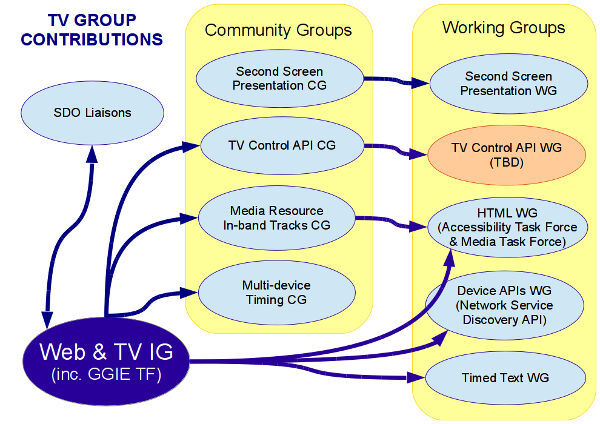One to watch: Web and TV progress
That TV and video is moving to the web is not new — a recent report by Nielsen showed that the number of American households subscribing to an internet video streaming service is already 40%. However there are still areas where these services may not meet user expectations, for example when compared to the instant availability of broadcast TV or the full-featured extras in DVD releases. Equally, broadcasters are increasingly integrating the web into their services but these experiences often need to be more seamless to encourage broad adoption. There are also new ways to enjoy content that the web has the potential to realize, such as multiple simultaneous camera views or customizable synchronization with other online and data services.
There are several groups within W3C working to make this a reality and the entry point for this activity is the Web and TV Interest Group. It's here where use cases and requirements are established and gaps in standards are identified. Most recently, the needs of video delivery on the web today include:
- Multi-screen content delivery
- Stream synchronization
- TV function and channel control
- Mixed media sources and content overlays
- Stream recognition and identification
- Server-side content rendering (e.g. for low-powered STBs)
- Improvements to existing features (e.g. adaptive streaming, timed text)
The incubator-style role of the Web and TV Interest Group has led to the creation and support of various groups that are aiming to address these issues and currently there are some exciting developments to be aware of and ideally participate in.

GGIE (Glass-to-Glass Internet Ecosystem) Task Force
GGIE (Glass-to-Glass Internet Ecosystem) Task Force
A young Task Force within the Web and TV Interest Group that has attracted a lot of attention, it has a broad focus of looking at all phases of the video life cycle: Capture → Edit → Package → Distribute → Find → Watch. The ultimate goal is to identify essential elements in digital video's life cycle and features that would be appropriate for recommendation for standardization in the appropriate SDOs, not just W3C. To achieve this, the Task Force is currently gathering use cases and all members of the Web and TV Interest Group are welcome to join in the discussion. See the Task Force page for more.
TV Control API Community Group
TV Control API Community Group
Thanks to the contributions of a growing number of participants, an API to control TV-like content and features is taking shape with the hope of eventually producing a new standard for media devices, set-top-boxes and of course televisions. We've used existing TV APIs for reference but there's still lots of work to do on the draft specification for it to one day become a standard. See the group page for more and to join. The Mozilla Hacks blog also a good summary of the TV Control API.
Multi-device Timing Community Group
Multi-device Timing Community Group
The newest TV-related group looking at how to accurately synchronize media streams across the web. This could be friends on a train wanting to watch the same movie on their separate devices, laughing at the same time. Another use case is watching a sports event on a large screen and having a separate single player or athlete view on your phone or tablet. Some interesting demos have been presented to the group but it's still early days and a great opportunity to influence its direction and deliverables. See the group page for more and to join.
Media Resource In-band Tracks Community Group
Media Resource In-band Tracks Community Group<
This group is developing a specification defining how user agents should expose in-band tracks as HTML5 media element video, audio and text tracks. In other words, web applications would be able to access information (e.g. metadata, captions, translations, etc.) within media stream containers through the media element. The draft specification that the group is working on currently covers the following media stream container types:
- MPEG-2 Transport Stream (MPEG-2 TS) (video/mp2t)
- ISO Base Media File Format (ISOBMFF aka MP4) (*/mp4)
- WebM (*/webm)
- OGG (*/ogg)
- DASH (application/dash+xml)
Other formats could be considered in the future, such as RTP streams. . See the group page for more and to join.
Second Screen Presentation Community Group & Working Group
Second Screen Presentation Community Group & Working Group
The Web and TV Interest Group also closely follows this work which is a good example of the evolution of an idea to a standard — it started as a proposal brought to W3C with a Community Group created for easy collaboration. A draft specification for displaying web content on secondary screens was edited and improved by a variety of stakeholders to the point where it formed the basis of a new Working Group. At this point it's officially on the standards track and further stabilization should see it implemented and brought to a big screen new you. Meanwhile, the Community Group remains open to foster discussion and ideas for future features. See the Community Group page and the Working Group page for more.
These are just some of the recent developments and as you can see, now is a prime time for those wanting to influence and guide new standards that will affect video on the web worldwide.
No quiero ser molesto pero creo que se necesita.
Gustavo ramos.
thankes
Thanks
Thanks again and still waitting for RTP streams.